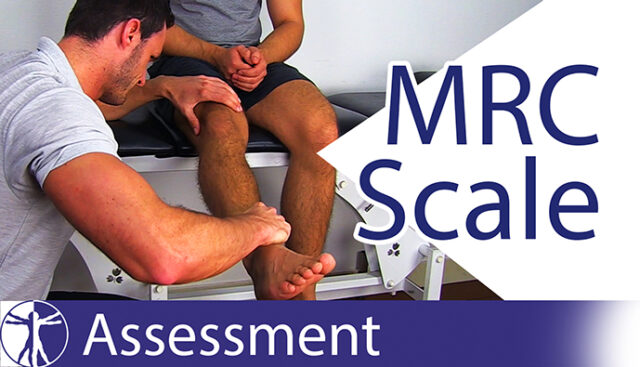Learn
MRC Scale | Muscle Strength Grading | Strength Testing
MRC stands for Medical Research Council which is the institution that sets up the standard for muscle strength testing.
The levels are as follows:
- Grade 0: The patient cannot activate the muscle, so no movement is observed. For grade 0, ask the patient to contract his quadriceps. He can do this by pushing the back of his knee into the bench. For grade 0, I will not see or feel a flicker or trace of contraction or movement.
- Grade 1: the patient can activate the muscle, without moving the limb. So only a trace or flicker of movement is seen or felt during palpation of the muscle. For grade 1, ask the patient to do the exact same thing, and this time, you will see or feel a muscle flicker or trace of movement.
- Grade 2: movement over the full range of motion can only occur if gravity is eliminated. In order to distinguish between grades 1 and 2, we have to bring our patient in side-lying position to eliminate gravity. Then, I will support the leg of my patient, bring it into full flexion and ask my patient to move into extension. If my patient is able to move through the full range of motion, this is a grade 2. If no movement is possible at all, we are talking about grade 1.
- Grade 3: the patient can overcome gravity and move through the full range of motion without resistance coming from the examiner. For grade 3, I’ll ask my patient to extend his knee against gravity.
- Grade 4: weakness with resistance. So your patient can move through the full range of motion with moderate resistance coming from the examiner. For grade 4, I will give moderate resistance against the extension of my patient’s knee.
- Grade 5: full strength. So your patient can move through the whole range of motion against full resistance coming from the examiner.And for grade 5, give full resistance against the extension of the patient’s knee. In order to distinguish between a grade 4 and 5, make sure to compare both legs.
Now that you’ve seen the basics of how to test according to the MRC scale, make sure to practice this with different joints and muscles and figure out a way of how to position your patient.
21 OF THE MOST USEFUL ORTHOPAEDIC TESTS IN CLINICAL PRACTICE

References
–
Like what you’re learning?
BUY THE FULL PHYSIOTUTORS ASSESSMENT BOOK
- 600+ Pages e-Book
- Interactive Content (Direct Video Demonstration, PubMed articles)
- Statistical Values for all Special Tests from the latest research
- Available in 🇬🇧 🇩🇪 🇫🇷 🇪🇸 🇮🇹 🇵🇹 🇹🇷
- And much more!








